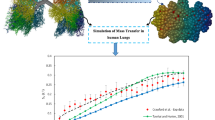Abstract
Studying the deposition pattern of inhalable particles in the pulmonary acinus has significance in clarifying the predisposing cause, progression, clinical treatment and prevention of common respiratory system diseases such as emphysema. In this study, we established an in vitro experimental model capable of simulating pulmonary acinar morphological lesions, such as emphysema and pulmonary atrophy. In addition, the deposition efficiencies of inhalable particles with various diameters in the pulmonary acinus were investigated under an unsteady state respiratory mode. The changes in pulmonary acinar morphology significantly affected the deposition rates of particles. Moreover, alveolar atrophy increased the deposition rate of particles, while pulmonary alveolar dilatation decreased the deposition rate. The results of this study may provide experimental evidence for the development of a disease course by pulmonary acinus morphologic changes. The established model also provides a feasible in vitro experimental model for studying the deposition pattern of inhalable particles in the pulmonary acinus.









Similar content being viewed by others
References
Tsuda, A., Henry, F. S., & Butler, J. P. (1995). Chaotic mixing of alveolated duct flow in rhythmically expanding pulmonary acinus. Journal of Applied Physiology, 79(3), 1055–1063.
Darquenne, C., Harrington, L., & Prisk, G. K. (2009). Alveolar duct expansion greatly enhances aerosol deposition: A three-dimensional computational fluid dynamics study. Philosophical Transactions, 367(1896), 2333–2346.
Sznitman, J., Heimsch, T., Wildhaber, J. H., Tsuda, A., & Rösgen, T. (2009). Respiratory flow phenomena and gravitational deposition in a three-dimensional space-filling model of the pulmonary acinar tree. Journal of Biomechanical Engineering, 131(3), 031010–031026.
Darquenne, C. (2014). Aerosol deposition in the human lung in reduced gravity. Journal of Aerosol Medicine and Pulmonary Drug Delivery, 27(3), 170–177.
Hofemeier, P., Koshiyama, K., Wada, S., & Sznitman, J. (2018). One (sub-)acinus for all: Fate of inhaled aerosols in heterogeneous pulmonary acinar structures. European Journal of Pharmaceutical Sciences, 113(15), 53–63.
Sznitman, J., Heimsch, F., Heimsch, T., Rusch, D., & Rösgen, T. (2007). Three-dimensional convective alveolar flow induced by rhythmic breathing motion of the pulmonary acinus. Journal of Biomechanical Engineering, 129(5), 658–665.
Ma, B., & Darquenne, C. (2011). Aerosol deposition characteristics in distal acinar airways under cyclic breathing conditions. Journal of Applied Physiology, 110(5), 1271–1282.
Oakes, J. M., Day, S., Weinstein, S. J., & Robinson, R. J. (2010). Flow field analysis in expanding healthy and emphysematous alveolar models using particle image velocimetry. Journal of Biomechanical Engineering, 132(2), 021008–021017.
Li, Z., Zhang, H., Cui, H., & Li, Y. (2016). Numerical simulation on characteristics of airflow and particles depositon in three-dimensional pulmonary acinus. Chinese Journal of Applied Mechanics, 33(5), 806–812.
Hofemeier, P., & Sznitman, J. (2016). The role of anisotropic expansion for pulmonary acinar aerosol deposition. Journal of Biomechanics, 49(14), 3543–3548.
Chhabra, S., & Prasad, A. K. (2010). Flow and particle dispersion in a pulmonary alveolus. Part 1. Velocity measurements and convective particle transport. Journal of Biomechanical Engineering, 132(5), 051009–051021.
Berg, E. J., Weisman, J. L., Oldham, M. J., & Robinson, R. J. (2010). Flow field analysis in a compliant acinus replica model using particle image velocimetry (PIV). Journal of Biomechanics, 43(6), 1039–1047.
Fishler, R., Mulligan, M. K., & Sznitman, J. (2013). Acinus-on-a-chip: A microfluidic platform for pulmonary acinar flows. Journal of Biomechanics, 46(16), 2817–2823.
Fishler, R., Hofemeier, P., Etzion, Y., Dubowski, Y., & Sznitman, J. (2015). Particle dynamics and deposition in true-scale pulmonary acinar models. Scientific Reports, 5, 14071–14082.
Fishler, R., Ostrovski, Y., Lu, C. Y., & Sznitman, J. (2017). Streamline crossing: An essential mechanism for aerosol dispersion in the pulmonary acinus. Journal of Biomechanics, 50, 222–227.
Listed, N. (1994). Human respiratory tract model for radiological protection. A report of a Task Group of the International Commission on Radiological Protection. Annals of the Icrp, 24(1–3), 1.
Haefeli-Bleuer, B., & Weibel, E. R. (1988). Morphometry of the human pulmonary acinus. Anatomical Record Advances in Integrative Anatomy & Evolutionary Biology, 220(4), 401–414.
Żywczyk, Ł., & Moskal, A. (2012). Modeling of the influence of tissue mechanical properties on the process of aerosol particles deposition in a model of human alveolus. Journal of Drug Delivery Science & Technology, 22(2), 153–159.
Sznitman, J. (2008). Respiratory flows in the pulmonary acinus and insights on the control of alveolar flows. Paper presented at the International Conference on Sensors and Control Techniques (ICSC2000).
Chen, J. H., Yuan, Z., Sheng, D. R., & Wei, L. I. (2012). Thermodynamic properties calculation method for moist air: 173 to 647 K. Journal of Zhejiang University (Engineering Science Edition), 46(4), 599–603.
Ding, Y. L., Cang, D. Q., & Yang, T. J. (1994). Concentration and viscosity of solid phase in a fully developed dilute gas-solid vertical flow. Journal of University Offence & Technology Beijing, 16(1), 20–25.
Sznitman, J. (2013). Respiratory microflows in the pulmonary acinus. Journal of Biomechanics, 46(2), 284–298.
Hofemeier, P., & Sznitman, J. (2015). Revisiting pulmonary acinar particle transport: Convection, sedimentation, diffusion, and their interplay. Journal of Applied Physiology, 118(11), 1375–1385.
Oakes, J. M., Hofemeier, P., Vignonclementel, I. E., & Sznitman, J. (2015). Aerosols in healthy and emphysematous in silico pulmonary acinar rat models. Journal of Biomechanics, 49(11), 2213–2220.
Oakes, J. M., Marsden, A. L., Grandmont, C., Darquenne, C., & Vignon-Clementel, I. E. (2015). Distribution of aerosolized particles in healthy and emphysematous rat lungs: Comparison between experimental and numerical studies. Journal of Biomechanics, 48(6), 1147–1157.
Nai-Fang, F. U., Dong, Z. C., Xian-Jun, L. I., Chen, X. Q., Pan, R. H., Zheng, Y. Y., et al. (2016). Research progress on treatment methods of occupational pneumoconiosis. Occupation & Health, 32(24), 3452–3456.
Huang, C., & Respiration, D. O. (2016). Treatment and effect of chronic obstructive pulmonary emphysema. China Continuing Medical Education, 4(26), 105–106.
Acknowledgements
This work was supported by the National Natural Science Foundation of China (Grant No. 31070832).
Author information
Authors and Affiliations
Corresponding author
Rights and permissions
About this article
Cite this article
Li, R., Xu, XX., Qiao, Y. et al. Experimental Research on the Impact of Alveolar Morphology on Deposition of Inhalable Particles in the Human Pulmonary Acinar Area. J. Med. Biol. Eng. 39, 470–479 (2019). https://doi.org/10.1007/s40846-018-0419-5
Received:
Accepted:
Published:
Issue Date:
DOI: https://doi.org/10.1007/s40846-018-0419-5




